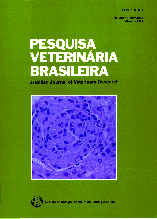 |
|
|
|
Year 1999 - Volume 19, Number 2
|

|
Experimental poisoning by the burs of Xanthium cavanillesii (Asteraceae) in sheep, 19(2):71-78
|
ABSTRACT.- Loretti A.P., Bezerra P.S., Ilha M.R.S., Barros S.S. & Barros C.S.L. 1999. [Experimental poisoning by the burs of Xanthium cavanillesii (Asteraceae) in sheep.] Intoxicação experimental pelos frutos de Xanthium cavanillesii (Asteraceae) em ovinos. Pesquisa Veterinária Brasileira 19(2):71-78. Depto Patologia Clínica Veterinária, Faculdade de Veterinária, Universidade Federal do Rio Grande do Sul, Av. Bento Gonçalves 9090, Cx. Postal 15094, Porto Alegre, RS 91540-000, Brazil.
The ground burs of Xanthium cavanillesii (Asteraceae) were force fed to 15 adult sheep in single doses or divided in two doses. Nine sheep died. Doses of 2 g/kg and above were lethal for the sheep. A single dose of 1,25 g/kg and a total of 2,5 g/kg divided in two administrations of 1,25 g/kg consecutive daily doses did not cause the toxicosis. Clinical signs were observed only in the animals that died and occurred between 5 hours and 20 hours after the beginning of the administration of the burs. The toxicosis had a peracute (90 minutes to 3 hours) to acute (9 to 13 hours) course. Clinical signs included apathy, anorexia, decreased rate and intensity of ruminai movements, generalized muscle tremors, stiff and incoordinated gait, unwillingness to move, instability, falls and recumbency. Most affected sheep presented seromucous nasal discharge with labored breathing. In terminal stages, there were trismus, drooling of saliva, convulsive seizures, nystagmus, paddling movements, periods of apnea and death. Main necropsy findings included accentuation of the lobular pattern of the liver, focal hemorrhages on thé capsular and cut surfaces, distension accompanied by edema and hemorrhages of the gall bladder wall, ascites, hydrotorax, and translucent and gelatinous perirenal edema. The contents of the cecum and proximal loop of the ascending colon were dry, impacted and covered by mucos and streaks of clotted blood; there were disseminated petechiae and suffusions. The main histopathological change consisted of marked coagulative hepatocellular necrosis, which varied from centrilobular to massive, associated with congestion and hemorrhages. In the remaining of the hepatic lobule there was either swelling or vacuolation of the hepatocytes. |
| |
|
|
| |
|
 |